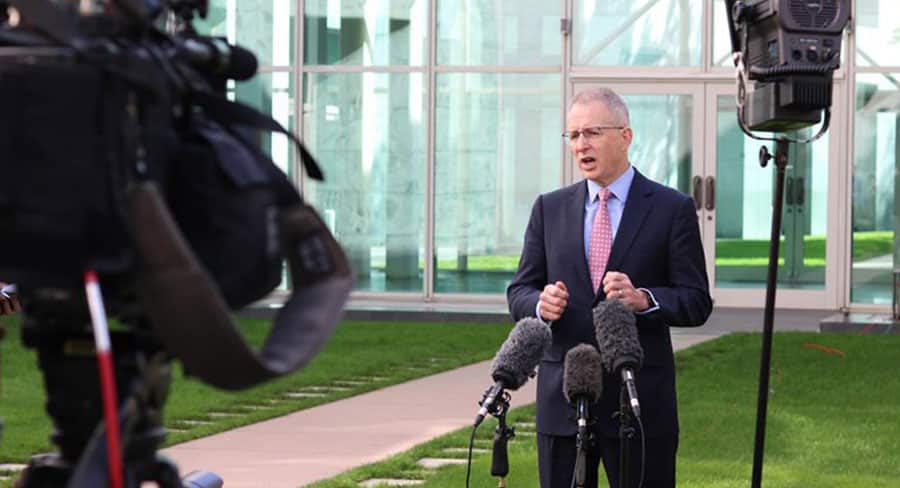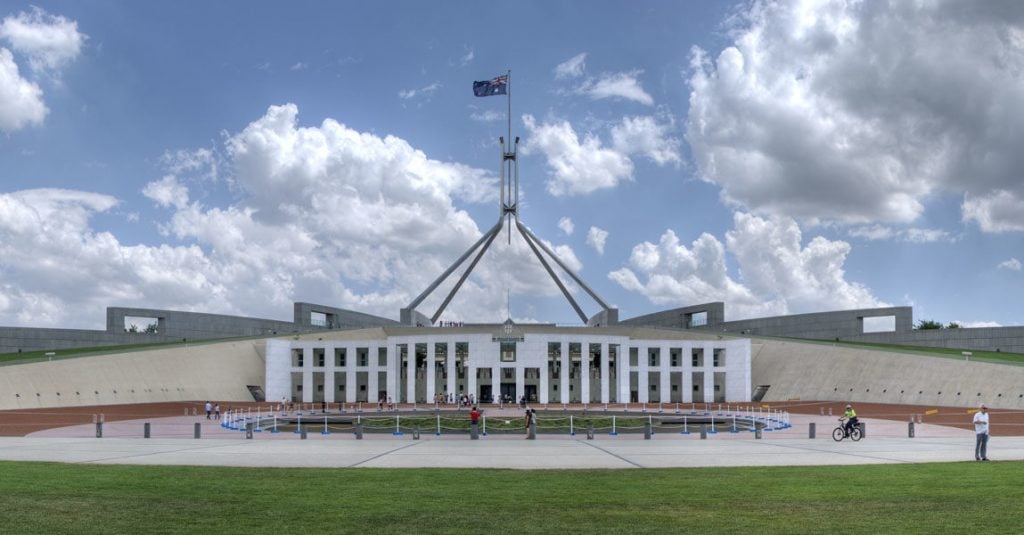Earlier this month, minister for communications, urban infrastructure, cities and the arts, Paul Fletcher announced that the ABC and SBS will receive a boost totaling $4.2 billion in funding. At the same time, the government announced planned reforms to the television sector as a whole.
February also marks 12 months since the senate presented its report into the Media Code laws that dominated headlines – and handshakes – for much of 2021.
Mediaweek spoke to Fletcher about the recent announcements, the Media Code laws, and what the future of the industry could look like.
Media Reforms
In a move that breaks from previous Coalition governments, the ABC will get a funding boost of $3.2 billion over the period from July 1 2022 to June 30 2025. This number includes $45.8 million under the Enhanced News Gathering scheme, which is aimed at giving regional journalism a leg up. SBS will get $953.7 million over the same period.
“ABC funding and SBS funding is done in three years cycles called a triennium, and the next one commences July 1 this year,” says Fletcher. “So naturally, we’ve needed to come to a resolution on what the funding would be. For both organisations, there’s a normal process where each puts in a submission, we consider that and we reach our decision.
“We thought it made sense to announce it in a way that gave them plenty of certainty, well ahead of July 1 so that they can plan for the next three years. The whole purpose of the triennium and funding is that they can have some certainty in terms of their planning. Consistent with that principle, once we’ve made the decision, it made sense to announce it reasonably quickly.”
The announcent has also included the introduction of the National Broadcasters Reporting Framework and Statements of Expectations regarding the reporting by the two organisations. Fletcher says there are two principal areas of the framework.
“The first concerns regional and remote Australia – it’s a reporting requirement. We’re asking them to report on the number of staff they have in regional and remote Australia and some other details like their locations, and then programming in regional and remote Australia.
“The second area deals with Australian content, we’re asking them to report – both ABC and SBS – on their Australian content, and to agree on the format of that report with the Australian Communications and Media Authority.”

Fletcher says that the goal is to have as much standardised reporting across the broadcasters as possible when it comes to Australian content. This will hopefully deliver a more accurate picture of the Australian content making it to Aussie screens.
For the ABC and SBS however, Fletcher makes it clear that the National Broadcasters Reporting Framework doesn’t include a mandate.
“We are not imposing a specific mandate or a specific requirement on ABC and SBS. In terms of the number of hours they show, both of them have a general requirement in their statute for content, but they don’t have any specific requirement as to the number of hours of content.
“We’re not imposing a requirement as to the number of hours they broadcast, we’re simply asking them to report each year on the number of hours they do broadcast in each of the relevant categories. The aim is to be able to build up an accurate picture across the whole free-to-air sector – commercial and national – as to Australian content being commissioned and broadcast.”
It’s not just the public broadcasters who will be affected, with a proposed Streaming Services Reporting and Investment Scheme designed to incentivise SVOD services to invest in Australian content as well.
“In the last few years we’ve had the streaming services come along, really out of nowhere, and in a very short period of time,” says Fletcher. “They’ve become a major part of the landscape, and that gives Australian consumers more choice. That is great, but as they reach the scale that they’re now at, it’s appropriate that they also should have obligations. If you’re making a lot of money in Australia, and they are earning a lot of money in Australia, we expect you to be spending at least some of that money on commissioning Australian content.
“What we’ve done is we’ve said that we’re going to legislate to do two things. Firstly, to require the streamers above a certain size – it will certainly include Amazon Prime, Disney+, and Netflix – to report on their Australian revenue and their Australian content spend. Then what the legislation will say is, if their Australian content spend as a percentage of their revenue in Australia is less than 5%, the minister will have the legal power to impose a formal target backed by the force of law.”
Media Code
On February 12th last year, the Australian Senate Economics Legislation Committee officially presented its report into the News Media and Digital Platforms Mandatory Bargaining Code, more commonly referred to as the Media Code laws.
12 months later, a number of major deals have been struck between tech giants Google and Facebook, and Australian media publishers. The bill is now due to be reviewed by the government, and for Fletcher, the last year has shown that the Media Code laws have been a success.
“My own view is that it’s been going well. There were a lot of people who were very sceptical, a lot of people said ‘oh, you’ll never be able to get an outcome with Google and Facebook’. People pointed to attempts made by European governments like Germany and Spain that didn’t succeed. They had to back down – or the publishers in particular had to back down. But we did this in a very methodical and careful way.”
While similar laws proposed overseas were unsuccessful, Australia’s laws have stuck. Fletcher says that this is because Google and Facebook know the consequences of non-cooperation.
“It worked, because they know that if they don’t do voluntary deals, then they can be designated under the code. If the treasurer makes a written designation, then they can be required to enter into compulsory arbitration. If the arbitrator sets the price they have to pay, then that will have legal effect. So they’ve chosen to instead do commercial deals.”
Whilst it’s one thing to say that the laws have worked, the proof for Fletcher is in the tangible results.
“Looking back on it after 12 months, you’d have to say it’s been a significant success. Just before Christmas, we saw the ABC announcing 50 additional journalists in regional and remote Australia paid for out of the proceeds of the deal they’ve struck with Google and Facebook. We’ve seen News Corp employing more cadet journalists, we’ve seen the Financial Review and the Herald and The Age employing more journalists. They’ve all said that a factor in that is the revenue they’re getting under the News Media Bargaining Code.”

Looking Ahead
When asked what hurdles he thought that the industry would be facing in the short term, Fletcher says that the disruptions caused by streaming services and Covid have had significant impacts.
“We have seen some significant trends over the past few years in reduction in peak viewer numbers for free-to-air television, and competition from the streamers for eyeballs. That, of course, then gets reflected – if you’ve got smaller audiences, that impacts on advertising revenue. The abundance of choice is a good thing for consumers, but it creates greater pressures for incumbent media businesses.
“In addition to that, the short term impacts of Covid, particularly in 2020, were very challenging. There was a significant drop in advertising revenue to the free-to-airs and to other media businesses. We stepped in with relief, including our $90 million Public Interest News Gathering program, which provided cash payments to particularly regional media businesses to help them through a really severe downturn. We gave the commercial broadcasters a year of relief from the commercial broadcasting tax. Now, happily, they’ve seen quite significant rebounds in their business since that time.”
Looking forward, Fletcher says that he believes digital and BVOD strategies are some of the biggest lights on the horizon for the industry.
“We are seeing the free-to-air broadcasters and the newspaper businesses developing more and more effective digital strategies. Five years ago I think the view was really quite gloomy amongst a lot of the media sector, particularly newspapers.
“We’ve seen a lot of newspapers going out of business around the world. But I think if you talk to the major publishers today, they’re much more confident about the success and track record of their digital businesses and the revenue they’re getting from their digital subscribers.
“Similarly, I think we’re seeing the commercial free-to-air networks building up impressive BVOD business and getting additional advertising revenue streams. The upside they’re getting there still doesn’t match some of the shrinkage they’re seeing in their traditional business, but nevertheless, they’re making good progress. We’re seeing digital revenues being a growing share of the revenues of all of their news media businesses, so I think that’s certainly a reason for some optimism.”
